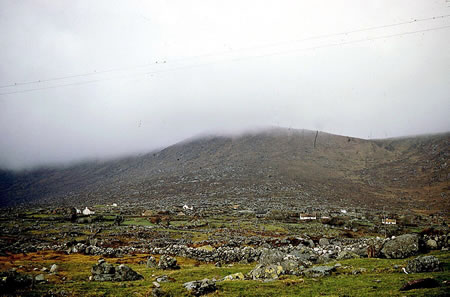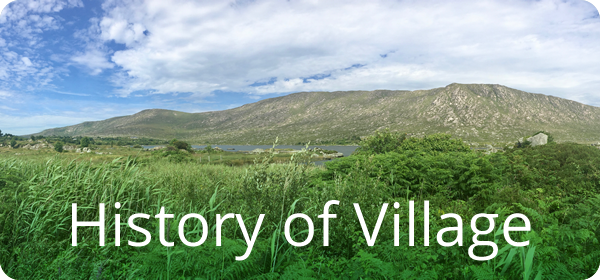Our Village
The townland of Loughaconeera is situated on the R340 road 40 miles west of Galway City. It is in the Electoral Division of Owengowla in the Parish of Moyrus, in the Barony of Ballynahinch. It covers an area of about 1,434 acres, of which the majority is bog and of very poor quality. Like every other townland in the area, it has seen a sharp decline in population in the last 20 years. Figures show us there were only 51 people living in the village in early 2017.
As you travel west through this townland on the R340, the mountain to the north known as Cnoc Mordáin is immediately visible. With its steep rocky face it runs the full length of the townland and gives a sense of security and shelter from the northern winds. According to folklore, Mordán was associated with the Tuatha de Danann and was reputed to be the King of all Ghosts.
Origin of the name ‘Loch Con Aortha’
The placenames of Ireland are intertwined with the history of the country, and a lot can be gleaned from the names of townlands, rivers, fields, hills and glens. They give us an insight into the social history of the place and of the people who lived there.
The place name ‘Loch Con Aortha’ is difficult to account for, as the three words together have no meaning. A version of how Loch Con Aortha got its name was told by Eddie Bheairtle Ó Conghaile from Ard West and in turn told to him by Séamus Sheáin Mac An Iomaire, Cill Chiaráin, many years ago. The story goes that there is a certain flat stone at the top of the village, near Tommy Cloherty’s house, on which water lodges after rain and which is reputed to have healing powers for warts and other skin diseases. People would come to this stone and say these lines in Irish:
“Uisce chloch gan iarraidh, ní go d’iarraidh atáim”
“Uisce chloch gan iarraidh, ní go d’iarraidh atáim”
“Uisce chloch gan iarraidh, ní go d’iarraidh atáim,
ach ag iarraidh leigheas”.
If the words ‘chloch gan iarradh’ are repeated quickly they rhyme with ‘Loch Con Aortha’ and this has been proposed as the origin of the townland’s name. Interestingly, other versions of the name appear in historical documents, including ‘Loch Con Uidhre’, ‘Lochán Iarthach’, ‘Loch Uí Chonaire’, ‘Loch Mhac Con Uidhre.’




